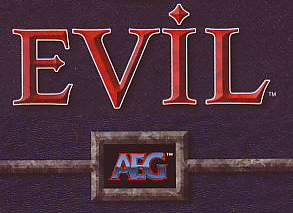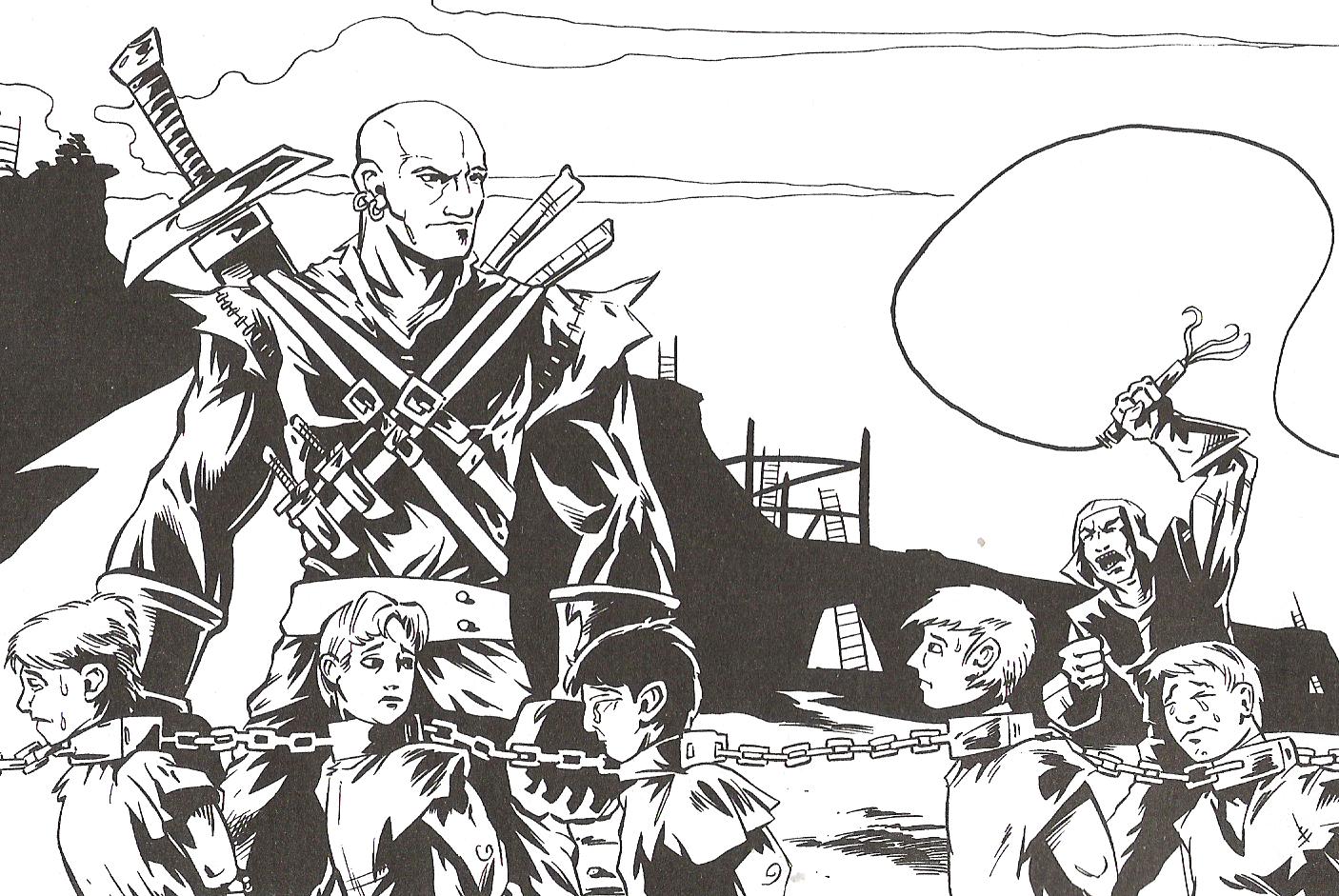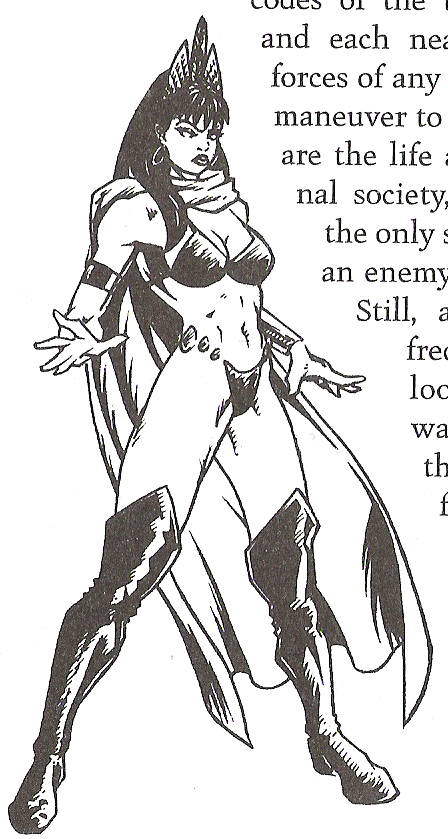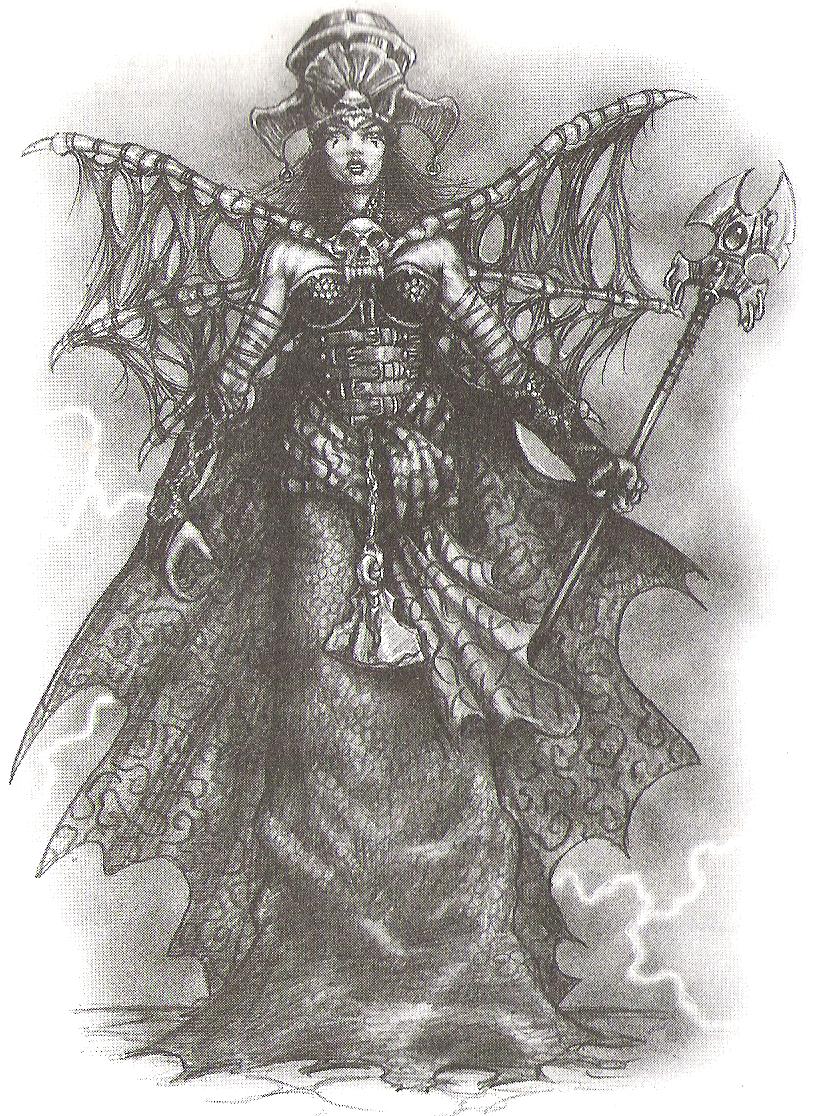Evil by PoptartsNinja
The Evil that Men Do
Original SA post
Who’s ready for 128 pages of pure EVIL™? Me too.
EVIL™ was released in 2001, about a year after the launch of D&D 3rd Edition. I’m not sure what niche in the ‘third edition ecosystem’ this book was intended to fill, but my gut says it was a quick and easy cash grab aimed at 14 year olds trying to be ‘edgy.’ So, all speculation aside, let’s crack this thing open.
EVIL™ was written by A. A. Acevedo, J.D. Douglass, Noah Dudley, Peter Flanagan, Chris Hussey, Mike Leader, Mike Mearles, jim pinto (sic), and Ree Soesbee.
I’m not sure why jim pinto wasn’t worthy of caps, but the very first thing I noticed is: this is consistent, jim pinto is also credited as an editor, the art director, and the project manager. My only conclusion is that jim’s name not being capitalized was intentional and that we have uncovered the first EVIL™ plot of the book! We’re off to a great start already!
Section One: The Evil That Men Do consists mostly of basic general advice for running villainous characters. All things considered, this is probably the best section since the core advice tends to be decent, even if it is obvious the writers were being paid by the word.
Oh, and I should also mention that the art is usually pretty good. Usually.

The very first header of Section One is Defining Evil , which is two paragraphs long and fails to define evil but does offer some potentially good advice which I will paraphrase: You can use bigger monsters and stronger spells to challenge the PCs, or you can use smarter monsters working in organized groups. This makes sense in theory, but not even Drizzt could make a thousand Orcs more frightening than a Balor.
It’s also a preface to
 about the evil D&D alignments. You’ve heard it all before, but EVIL™ comes to some startling conclusions:
about the evil D&D alignments. You’ve heard it all before, but EVIL™ comes to some startling conclusions:
Chaotic Evil is lazy evil, and tends to represent either lone crazy people or monsters so individually powerful that they couldn’t care less about ever developing a personal morality. The book also insists they’re glass canons who aren’t in it for the long haul. I’m sure the Red Dragon and/or the Balor have something to say about that.
Lawful Evil is sneaky evil. Lawful Evil isn’t going to commit to a fair fight when it can smother you in your sleep or change the zoning laws to turn your house into a freeway. Lawful Evil bears a striking resemblance to Chaotic Evil.
Neutral Evil is, as usual, where things fall apart. The book waffles between describing it as exactly like chaotic evil; and describing it as exactly like lawful evil except more self-centered. So, exactly like lawful evil. Then the book says Neutral Evil is nothing like what it just said, and that Neutral Evil is the most unpredictable form of EVIL™.

Now, stop me if I’m wrong, but in third edition D&D “unpredictable evil” was already a thing. It’s called Chaotic Evil . So Neutral is still the dumbest alignment, and EVIL™ still fails to justify why it exists.
Evil™ then asks Why Evil? in the next heading, then says that nearly every villain’s motives can be characterized in terms of D&D’s three evil alignments. Yes, we’re still talking about the alignments I guess. Our
 counter rises to 1 as the book talks about “jackbooted sadists” for a paragraph before suddenly calling “dinosaurs, sharks, badgers, and lions” Chaotic Evil monsters.
counter rises to 1 as the book talks about “jackbooted sadists” for a paragraph before suddenly calling “dinosaurs, sharks, badgers, and lions” Chaotic Evil monsters.

EVIL™ then fails spectacularly to justify Neutral Evil again:
Evil™ talking about Neutral Evil again posted:
Lawful Evil and Chaotic Evil find excuses for what they do. Not these villains. Neutral Evil is all about you, you, you. […]It’s a dog-eat-dog world out there, friend, and if you’re not looking out for Number One you’re wearing bone underclothes.

I’m going to run out of psyducks for this book, but credit where it’s due that is some pretty evocative imagery.
The next header is Making Evil Look Good , and there’s some genuinely good advice in here. Summarized: the difference between an effective villain and a forgettable one is style. It doesn’t do a good job of defining what style is, but it’s still good advice for a new GM. This advice is then lost in paragraph after paragraph of Saturday Morning Cartoon Villain as it attempts to describe a recurring villain; then ends with another bit of good advice:
MELG posted:
Even if you feel the urge to go over to good, do it in a big way. No one is impressed with wishy-washy evil.
The next header, Who Says We’re Evil? , basically amounts to: give your villains actual motives, since very few people are going to murder for murder’s sake. Obvious? Yes, but maybe it wasn’t to a 14 year old back in 2001.
The header after that Evil and Proud of It throws that good advice out the window and says: sometimes EVIL™ is just EVIL™
We’re then treated to two pages of a villain monologuing, which I will spare you.
Fallen Heroes is actually deserving some attention, since it puts an emphasis on how and why a villain becomes a villain. Skipping over the obvious, this section discusses some of the common reasons for a hero to fall: Betrayal, torture, cowardice, love, magic, and revenge are the six listed.
I think this is where I’ll call it for now. Next time EVIL™ will talk about untrustworthy backstabbing idiots, followed immediately by talking about Demons. Also: sexism.
Running Evil Campaigns
Original SA post
Picking up where we left off, we’re immediately presented with an extremely inappropriate sidebar. Interrupting their advice for GMs on how to play evil villains, EVIL™ interrupts itself (how nefarious!) to do some worldbuilding for… nothing. This sidebar is in a really weird place, but it’s worth talking about since it contains the gem of a good idea:
The Sisters of Dust is an organization of all-woman Necromancers who study death in order to learn how to better heal the living.
I like that, it’s short, concise, and—oh, they spent half of an entire page talking about them. Why is this here and not among the prestige classes? Because it’s not a prestige class. I checked. They put a lot of emphasis on the Sisters of Dust being all-women even though that strikes me as a campaign-specific detail. I suppose they couldn’t use “Dustmen” though. I miss Planescape.
Right, so, awkward sidebar done with, the next heading is Common Cause which is GM advice for running an evil campaign. Now, I’m a big fan of “evil overlord” campaigns wherein the players are playing something like neighboring dragons enacting vanity plans that take centuries, or an Overlord’s trusted Lieutenants doing their best to avoid a one-way visit to the Kraken pens, so this should be right up my alley right? I am not anticipating good things.
So, EVIL™’s first assumption is very oldschool: all D&D players are murderous idiots who will rob and kill each other the moment they write ‘EVIL™’ on their character sheet.
Fortunately, and this surprised me, EVIL™ does make a good effort to discourage players in evil campaigns from actually doing this. I came into this expecting utter garbage and so far most of the actual advice as been on the positive side of ok. I’m not sure what I was expecting when we started the “roleplaying an evil character” section, but it wasn’t this:
EVIL™ posted:
These are still your friends sitting around the table with you, and unless you’ve agreed in advance that you’re playing against each other, this sort of campaign can have tensions running high. And if you actually succeed in killing off the others, it either becomes a much smaller group or the new characters come in knowing that the last person standing wins.
It then talks for a paragraph or so about how evil groups can work together well: it comes down to individual motivations, if the party all have separate but equally feasible goals, then they can feel comfortable helping each other since they all want slightly different forms of power in the end.
The next heading, Who’s In Charge Here , opens with a little italics section that I’m going to quote:
EVIL™ posted:
“Ok, so one of your spies stumbles into your secret lair,” the DM begins.
“Is it about my plot to corrupt the priests of the Sun God?”
“It’s probably one of my informants with the skinny on where Mr. Hot-Shot Paladin is.”
“Did he find out who has the Wand of Power?”
“Those idiots on the border had better not give away my Legions of Doom.”
“Sigh…”
Ok, in all honesty? That sounds like four players having a lot of fun. They have plots going, rivalries, and personal ambitions that aren’t interfering with each other. It’s supposed to showcase the difficulty of DMing an evil campaign, but all the problems in the above section are the DM’s fault: by specifying which of the player’s spies was returning he could’ve nipped the derail in the bud.
The section then goes on to discuss the differences between a Good and EVIL™ game, insisting that villains are usually active heroes are usually reactive; which means that a GM used to be the one making the world move might be a little disoriented when he’s the one who has to react to the players instead. This is absolutely true in an EVIL™ campaign, since the players are absolutely going to pursue their own plans and can test a GM’s ability to improvise. This is not a flaw, and EVIL™ both acknowledges this and then offers good advice on how to keep it from becoming problematic.
EVIL™ advises the GM to, and bear with me on this because I know it’s strange, talk with the players and get a feel for their general motives and plans in advance to make sure you’re not offering inappropriate plot-hooks. This may be the best advice in the entire book and I’m amazed it’s in here at all.
It then demolishes my positive reactions by encouraging the GM to, well:
EVIL™ posted:
There’s always the possibility of taking the dungeon and reversing the roles, forcing the villains to react to heroes. This allows the DM to craft an adventure where the players can act in character while the DM is still in control.

Come, we must plan for tomorrow because we’ve reached the end of the good advice train. Instead, this section discourages the players by telling them that their plans are probably going to be wrecked by random adventurers. It’s trying to encourage them to have a fallback plan or two; but instead is basically saying “you can’t win, so fuck it.”
We then move on to the section I was dreading: The Other Side of Evil , which talks about Demons and Devils. This is going to become important since a good portion of this book is about summoning Demons and Devils. This is going to get rough, so buckle up:
Summoned Demons have to be
Summoned Devils are fops, apparently, but they’ll take pacts and contracts and follow the precise letter. If a Devil bargains with you it’s stupid.
Also, since this picture was in this section, this is where I’ll share it:

Don’t ask me how the Dark Queen got here, but I haven’t seen the BattleToads anywhere!
DAEMONS: A CODICIL is the next section. D&D has a third race of infernals called the Yugoloths, which were folded into the Demons in D&D 4th when the Neutral Evil alignment went away. They’re basically exactly like demons which means bargaining with them is stupid. Why do I keep mentioning this?
Bargains
EVIL™ pretty much says outright that bargaining with demons and devils is stupid, but people will still do it for power. Ok, that’s pretty reasonable.
EVIL™ posted:
Negotiating with a demon is much like arguing with a petulant child.
Ok, I’ll buy that. It suggests keeping terms simple such as “help me and I’ll help you” or “help me or I’ll trap you in a bottle for eternity,” which don’t seem like good bargaining postures to me but hey, bargaining with demons is stupid.
It then says that Devils are always happy to bargain with mortals, which makes them sound less like Devils and more like Ferenghi. Making a deal with a Devil would be one of the few cases where Profession: Barrister would be useful, but this section doesn’t even offer up that much advice. Instead, it portrays Devils as the ultimate Rules Lawyers, emphasizing Rules As Written wherever it’ll allow them to make a loophole to create Pun Pun or avoid grapple attempts.
That actually strikes me as a pretty decent idea for a non-serious character: a demon who can manipulate events because he knows the setting’s rulebook.
Serving a Dark Master is basically advice for a PC who wants to serve Satan. The advice is as follows: treat it like worshipping an evil god. Got it? No? Ok, let’s talk about it for ten paragraphs.
Talismans is where EVIL™ starts to go completely insane. Basically, by holding a Demon or Devil’s “talisman” hostage, you can force them to do what you want. This is a terrible mechanic, but it’s here to give the players an option in case they roll a natural 1 on their “convince the Demon to help me” roll. It says using a Talisman to control an extraplanar critter is risky and probably stupid, then includes a catch-all gotcha so the DM can snicker behind the player’s back by saying that another critter’s Talisman is the one thing any Demon or Devil would absolutely be willing to trade for.
I can see this working as campaign-specific advice, but EVIL™ isn’t supporting a campaign book. It’s a standalone, and so while this makes for an interesting adventure hook it isn’t really relevant. That’s going to be a trend from now on.
Next time: Infernal Pact Feats!

Infernal Pacts/Feats
Original SA post
Infernal Pacts talks about infernal pacts, which is basically a precursor to Infernal Pact Feats. You knew it was coming! If you have a demon or a devil for a Master, they can grant you demonic gifts in the form of (typically overpowered) feats. But hey, it wouldn’t be a 3rd edition splatbook without new feats and prestige classes, so let’s get right to it.
All Infernal Pact feats have a benefit and a drawback intended to balance them. This doesn’t always work and holy hell some of these feats are stupidly overpowered! Surprise! I’m going to go ahead and list them, but invariably every feat is either Prerequisite: Infernal Pact or Prerequisite: Infernal Pact + XP Loss (which would cause you to immediately lose the feat).
Broken Feats are marked with a

Feat: Infernal Pact
Benefit: You can take Infernal Pact feats
Drawback: You are trapped in an Evil alignment forever
Feat: Claws/Fangs
Benefit: 1d8 unarmed damage, you can take this twice (once for claws, once for fangs)
Drawback: You have claws and fangs
Feat: Darkvision

Benefit: You get Darkvision(60ft)
Drawback: You get kitty-cat eyes!
Feat: Elemental Resistance

Benefit: You gain energy resistance 25 against one energy subtype, you may take this feat multiple times
Drawback: You get hairy/soft/rubbery/scaly/or your skin turns green
Feat: Flight

Benefit: You can fly 1/day as the spell, you may take this feat multiple times
Drawback: You can’t bull rush as well
Feat: Improved Flight

Benefit: You can Fly as per the spell AT WILL
Drawback: You grow tiny anime girl demon wings, preventing you from wearing most armor oh wait no it doesn’t.
Feat: Immortality
Benefit: You don’t age and can’t die of old age
Drawback: You can still be killed, costs 5000xp
Feat: Immunity

Benefit: You are immune to all diseases, including magical diseases
Drawback: You have a persistent cough
Feat: Imp
Benefit: You gain an Imp familiar if you’re an Arcane spellcaster
Drawback: The Imp kills and eats your old familiar
Feat: Regeneration

Benefit: You regenerate as per the spell
Drawback: You are cold-blooded and take 2x damage from fire
Feat: Improved Regeneration

Benefit: You Regenerate as per the Supernatural ability, all damage taken is subdual, you may take this feat multiple times
Drawback: You are a pasty nerd and lose 1 Charisma forever, but even that's a price well worth it!
Feat: Increased Movement

Benefit: +20ft movement
Drawback: Your feet are cloven hooves, you can’t wear boots (but can you wear horseshoes?)
Feat: Infernal Soul
Benefit: You gain 10 hp
Drawback: You radiate evil so Paladins can detect you from further away
Feat: Invisibility
Benefit: You can turn invisible 1/day as per the spell, can be taken multiple times for extra uses
Drawback: You lose an effective 3 charisma for skill tests
Feat: Shapechange

Benefit: You can Shapechange as the spell 1/day, can be taken multiple times for extra uses
Drawback:
Feat: Wealth
Benefit: Gain 15,000 GP
Drawback: Nothing
Feat: Magic Item
Benefit:
Drawback: Requires Wealth, the item might be cursed
Feat: Multiple Limbs
Benefit: You grow two extra arms, legs, or a prehensile tail
Drawback: Requires Shapechange, you look like an idiot
Feat: Poison Blood
Benefit: Your blood is poison of your choice
Drawback:
Feat: Rot

Benefit: You inflict mummy rot any time you touch anyone
Drawback: You smell bad
Feat: Undetectable Lie
Benefit: Detect Lies can’t detect your lies
Drawback: You have a forked tongue
Feat: Unholy Blessing

Benefit: Permanent Unholy Aura
Drawback: You get Horns, just like in the hot new video game Fable!
Feat: Unholy Strength
Benefit: +2 Strength, can be taken multiple times
Drawback: You look like you have a Myosatin deficiency
Feat: Wish
Benefit: You gain a single wish
Drawback: You waste a feat
So, yeah. Those are all things. Also a thing: Prestige Class: Demon Summoner which is presented next.

Requirements: Wizard 5, Sorcerer 6, Cleric 7; evil alignment; some laughable skill requirements that most casters will take anyway, and they have to be able to speak Abyssal or Infernal. That’s it.
They’re spellcasters, d4hp, 2+int skills, gain spells as per their old class, and instead of having a ton of dead levels where only spells are gained, they gain six free metamagic or Infernal Pact feats over the course of their progression, get an apprentice (a free

Next Time: More demon summoning!